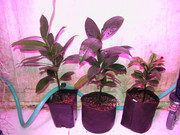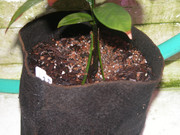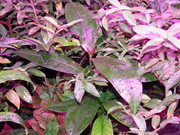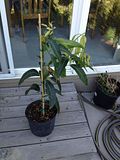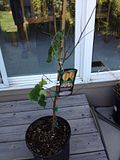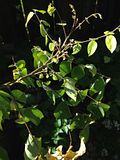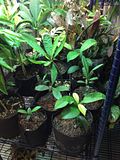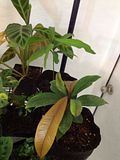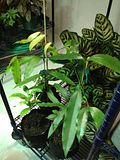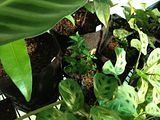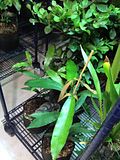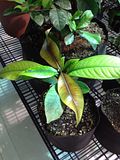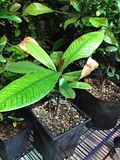1
Tropical Fruit Discussion / Asimina triloba experience in Colorado
« on: October 17, 2014, 02:41:27 AM »
In 1999 (15 years ago) I planted 2 Asimina triloba (pawpaw) seedlings, each 1 year old, of unknown but supposedly "good" parentage.
One didn't make it through the first winter, but the other slowly grew over the years.
Pawpaw are supposedly zone-5 hardy, but prefer acidic soil, low wind, and lots of water. My area of Colorado is zone 5 (-25F max-- at least in the past 20 years) of high-altitude (5200 feet above sea level) desert-- 14" moisture per year on average, with extremely alkaline (pH 8.2-8.4) heavy clay "soil". Even worse, we often have 6-8 weeks of warm non-freezing weather in the spring, followed by a hard freeze before the warm season really begins. Only 5 of the approximately 30 grafted and seedling trees I've planted to date survived their first winter. But my remaining original seedling tree has slowly grown each year and has never been fooled by the late frosts-- or the early frosts-- yet.
In 2009 (10 years old) it bloomed for the first time; I tried self-pollination but nothing set.
For the next 5 years (2010-2014) I drove to one or both of the other 2 blooming-size pawpaw trees in the state of Colorado (that I'm aware of) trying to cross-pollinate my tree. The other trees are 30 and 50 miles away from me, so a single act of cross-pollination takes 2-3 hours. No fruit set at all, until this spring.
This spring about 80% of the 70 or so flowers I hand-pollinated started setting fruit, whether the pollen was from my tree or another. Ultimately though, all the self-pollinated fruit clusters dropped off at about 1" long (per fruit). 3 cross-pollinated clusters held on and got larger-- 2 of 1 lobe / fruit, 1 of 2 lobes / fruits.
A visiting dog removed 1 of the fruits midway through the summer (along with the whole 4'x5' branch it was on). 15 years after planting it, and with 5 years of driving for hours each spring trying to cross-pollinate it, I wanted to taste the fruit.
Here are 2 of the 3 remaining fruit in mid-August:

I jealously guarded the remaining fruit from squirrels, who were luckily much more interested in the adjacent peach tree. It started getting cold here about a month ago; we could have had a frost or hard freeze many times by now, but the pawpaw fruit weren't showing any signs of ripeness.
4 days ago after several near-frosts and one very slight frost, I noticed that a squirrel had taken a bite out of one of the still-firm and fully green fruit. Fearing it would rot or get attacked again, I picked it.
I've been waiting 15 years to try this fruit, and I had to pick my first one before it wanted to come off the tree.

After sitting on the counter for 3 days, it started giving off a wonderful aroma of jackfruit and Granny Smith apples, but was still firm.
This evening it had the same fragrance, just more intense, and the undamaged fruit was soft, so I cut it open:

My first chance to try the fruit from a tenacious but otherwise unknown seedling (and my first pawpaw fruit ever):
Seed to flesh ratio: Poor; about 40% seed, 60% flesh. I got about 1/3 cup of flesh out of the fruit.
Texture: 90% ripe banana, 10% pear / ripe cherimoya. Very pleasant in my opinion.
Flavor: I'm horrible at describing flavor, but I'd say it was 90% really good cherimoya (though not quite as sweet), 10% bubble gum. No noticeable different aftertaste. Very, very tasty in my opinion. Almost worth waiting 15 years for, and certainly worth the drive to cross-pollinate next year if necessary. Hopefully next year I can get more than 3 fruit!
I still have 1 fruit hanging on the tree and the damaged fruit which will likely be eaten tomorrow-- it just isn't quite as soft as the one I ate tonight.
There's nothing quite like trying a new fruit for the first time; pawpaw has been on my list for a long time and it looks like I got lucky with a good-tasting seedling; I'd rather have a poor seed-to-flesh ratio than a poorly-flavored fruit with no seeds. I look forward to tasting the 7 other named varieties I've got growing!
Kevin
One didn't make it through the first winter, but the other slowly grew over the years.
Pawpaw are supposedly zone-5 hardy, but prefer acidic soil, low wind, and lots of water. My area of Colorado is zone 5 (-25F max-- at least in the past 20 years) of high-altitude (5200 feet above sea level) desert-- 14" moisture per year on average, with extremely alkaline (pH 8.2-8.4) heavy clay "soil". Even worse, we often have 6-8 weeks of warm non-freezing weather in the spring, followed by a hard freeze before the warm season really begins. Only 5 of the approximately 30 grafted and seedling trees I've planted to date survived their first winter. But my remaining original seedling tree has slowly grown each year and has never been fooled by the late frosts-- or the early frosts-- yet.
In 2009 (10 years old) it bloomed for the first time; I tried self-pollination but nothing set.
For the next 5 years (2010-2014) I drove to one or both of the other 2 blooming-size pawpaw trees in the state of Colorado (that I'm aware of) trying to cross-pollinate my tree. The other trees are 30 and 50 miles away from me, so a single act of cross-pollination takes 2-3 hours. No fruit set at all, until this spring.
This spring about 80% of the 70 or so flowers I hand-pollinated started setting fruit, whether the pollen was from my tree or another. Ultimately though, all the self-pollinated fruit clusters dropped off at about 1" long (per fruit). 3 cross-pollinated clusters held on and got larger-- 2 of 1 lobe / fruit, 1 of 2 lobes / fruits.
A visiting dog removed 1 of the fruits midway through the summer (along with the whole 4'x5' branch it was on). 15 years after planting it, and with 5 years of driving for hours each spring trying to cross-pollinate it, I wanted to taste the fruit.
Here are 2 of the 3 remaining fruit in mid-August:

I jealously guarded the remaining fruit from squirrels, who were luckily much more interested in the adjacent peach tree. It started getting cold here about a month ago; we could have had a frost or hard freeze many times by now, but the pawpaw fruit weren't showing any signs of ripeness.
4 days ago after several near-frosts and one very slight frost, I noticed that a squirrel had taken a bite out of one of the still-firm and fully green fruit. Fearing it would rot or get attacked again, I picked it.
I've been waiting 15 years to try this fruit, and I had to pick my first one before it wanted to come off the tree.

After sitting on the counter for 3 days, it started giving off a wonderful aroma of jackfruit and Granny Smith apples, but was still firm.
This evening it had the same fragrance, just more intense, and the undamaged fruit was soft, so I cut it open:

My first chance to try the fruit from a tenacious but otherwise unknown seedling (and my first pawpaw fruit ever):
Seed to flesh ratio: Poor; about 40% seed, 60% flesh. I got about 1/3 cup of flesh out of the fruit.
Texture: 90% ripe banana, 10% pear / ripe cherimoya. Very pleasant in my opinion.
Flavor: I'm horrible at describing flavor, but I'd say it was 90% really good cherimoya (though not quite as sweet), 10% bubble gum. No noticeable different aftertaste. Very, very tasty in my opinion. Almost worth waiting 15 years for, and certainly worth the drive to cross-pollinate next year if necessary. Hopefully next year I can get more than 3 fruit!
I still have 1 fruit hanging on the tree and the damaged fruit which will likely be eaten tomorrow-- it just isn't quite as soft as the one I ate tonight.
There's nothing quite like trying a new fruit for the first time; pawpaw has been on my list for a long time and it looks like I got lucky with a good-tasting seedling; I'd rather have a poor seed-to-flesh ratio than a poorly-flavored fruit with no seeds. I look forward to tasting the 7 other named varieties I've got growing!
Kevin





